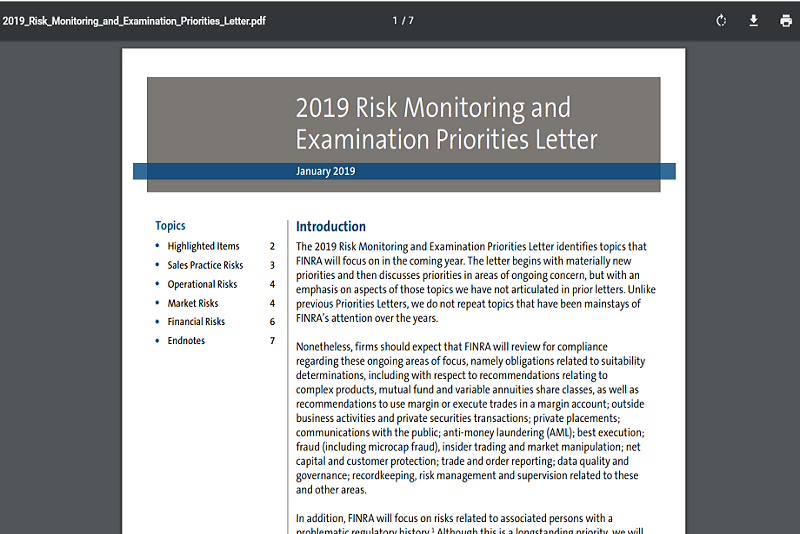BROWSE BY TOPIC
- Bad Brokers
- Compliance Concepts
- Investor Protection
- Investments - Unsuitable
- Investments - Strategies
- Investments - Private
- Features/Scandals
- Companies
- Technology/Internet
- Rules & Regulations
- Crimes
- Investments
- Bad Advisors
- Boiler Rooms
- Hirings/Transitions
- Terminations/Cost Cutting
- Regulators
- Wall Street News
- General News
- Donald Trump & Co.
- Lawsuits/Arbitrations
- Regulatory Sanctions
- Big Banks
- People
TRENDING TAGS
Stories of Interest
- Sarah ten Siethoff is New Associate Director of SEC Investment Management Rulemaking Office
- Catherine Keating Appointed CEO of BNY Mellon Wealth Management
- Credit Suisse to Pay $47Mn to Resolve DOJ Asia Probe
- SEC Chair Clayton Goes 'Hat in Hand' Before Congress on 2019 Budget Request
- SEC's Opening Remarks to the Elder Justice Coordinating Council
- Massachusetts Jury Convicts CA Attorney of Securities Fraud
- Deutsche Bank Says 3 Senior Investment Bankers to Leave Firm
- World’s Biggest Hedge Fund Reportedly ‘Bearish On Financial Assets’
- SEC Fines Constant Contact, Popular Email Marketer, for Overstating Subscriber Numbers
- SocGen Agrees to Pay $1.3 Billion to End Libya, Libor Probes
- Cryptocurrency Exchange Bitfinex Briefly Halts Trading After Cyber Attack
- SEC Names Valerie Szczepanik Senior Advisor for Digital Assets and Innovation
- SEC Modernizes Delivery of Fund Reports, Seeks Public Feedback on Improving Fund Disclosure
- NYSE Says SEC Plan to Limit Exchange Rebates Would Hurt Investors
- Deutsche Bank faces another challenge with Fed stress test
- Former JPMorgan Broker Files racial discrimination suit against company
- $3.3Mn Winning Bid for Lunch with Warren Buffett
- Julie Erhardt is SEC's New Acting Chief Risk Officer
- Chyhe Becker is SEC's New Acting Chief Economist, Acting Director of Economic and Risk Analysis Division
- Getting a Handle on Virtual Currencies - FINRA
ABOUT FINANCIALISH
We seek to provide information, insights and direction that may enable the Financial Community to effectively and efficiently operate in a regulatory risk-free environment by curating content from all over the web.
Stay Informed with the latest fanancialish news.
SUBSCRIBE FOR
NEWSLETTERS & ALERTS
FINRA 2019 Priorities Letter (Final Part Four) – Market Risks
by Howard Haykin
-
Best Execution
-
Market Manipulation
-
Market Access
-
Short Sales
-
Short Tenders
BEST EXECUTION. When assessing whether a firm uses reasonable diligence to assure that their customer order flow is directed to the best market - given the size and types of transactions, the terms and conditions of orders and other factors - FINRA will …
- review a firm’s Best Ex decision-making where the firm routed all or substantially all customer orders to a small number of wholesale market makers from which they received payment for order flow or an affiliated broker-dealer or an alternative trading system (ATS) in which the firm had a financial interest.
- assess how a firm checks additional venues for potential price improvement.
- review how a firm quantifies the benefits to customers from its receipt of order routing inducements and how it manages the conflict of interest between their duty of Best Ex and any inducements or benefits they receive from the routing or internalization of customer orders.
MARKET MANIPULATION. FINRA monitors market manipulation by enhancing its surveillance capabilities and providing firms with tools they can use to identify possible manipulative activities. In 2009, FINRA will focus on manipulative trading in correlated Exchange Traded Products or ETPs, including those that track common, broad market indices. FINRA uses pattern exploration to better identify the exploitation of the unique characteristics of ETPs, such as the creation and redemption process and composition changes to the ETP portfolios, and expanding the use of machine learning to improve its ability to react to changes in the ETP market. Similarly, FINRA will focus on reviews for potential manipulation across correlated options products (e.g., options on broad market indices and options on ETFs overlying the same indices).
FINRA will continue to help firms with their compliance efforts by providing Cross Market Supervision Report Cards, which help firms identify potential manipulation across multiple firms, markets and products and proactively address related compliance risks.
MARKET ACCESS. FINRA will continue to review firms’ compliance with Rule 15c3-5 (the Market Access Rule) under the Securities Exchange Act of 1934, focusing on how firms: (i) apply appropriate controls and limits to sponsored access orders; (ii) retain sole authority to determine the boundaries for those controls and limits; (iii) test the effectiveness of those controls and limits; and, (iv) implement and test exception reporting systems covering sponsored access orders. FINRA will also assess how firms monitor their customers’ activity and maintain pols and procedures, as well as technical controls, to detect and prevent potentially manipulative or other prohibited trading activity.
SHORT SALES. FINRA will review whether firms have structured their aggregation units in a manner that is consistent with the requirements of Exchange Act Rule 200(f) and can demonstrate the independence of the units through measures such as separate management structures, location, business purpose, and profit and loss treatment.
SHORT TENDERS. As in 2018, FINRA will review how firms account for their options positions when tendering shares in the offer. Exchange Act Rule 14e-4 provides that if, following the announcement of a tender offer, a market participant sells call options with a strike price less than the tender offer price, the firm must reduce its long position by the shares underlying the options for purposes of calculating its net long position. FINRA will continue to educate firms about these requirements and evaluate their compliance with them.





